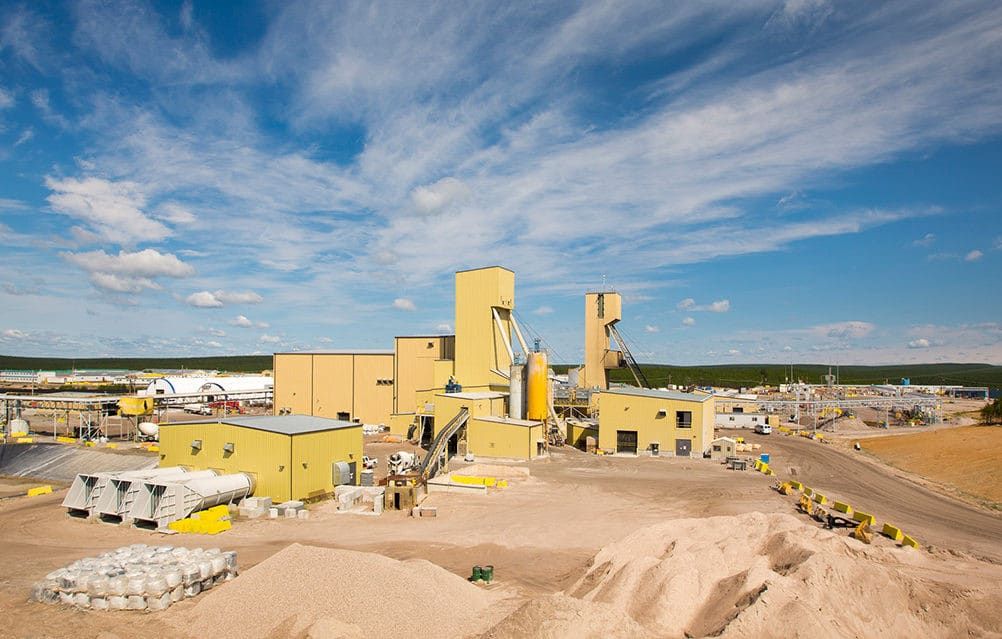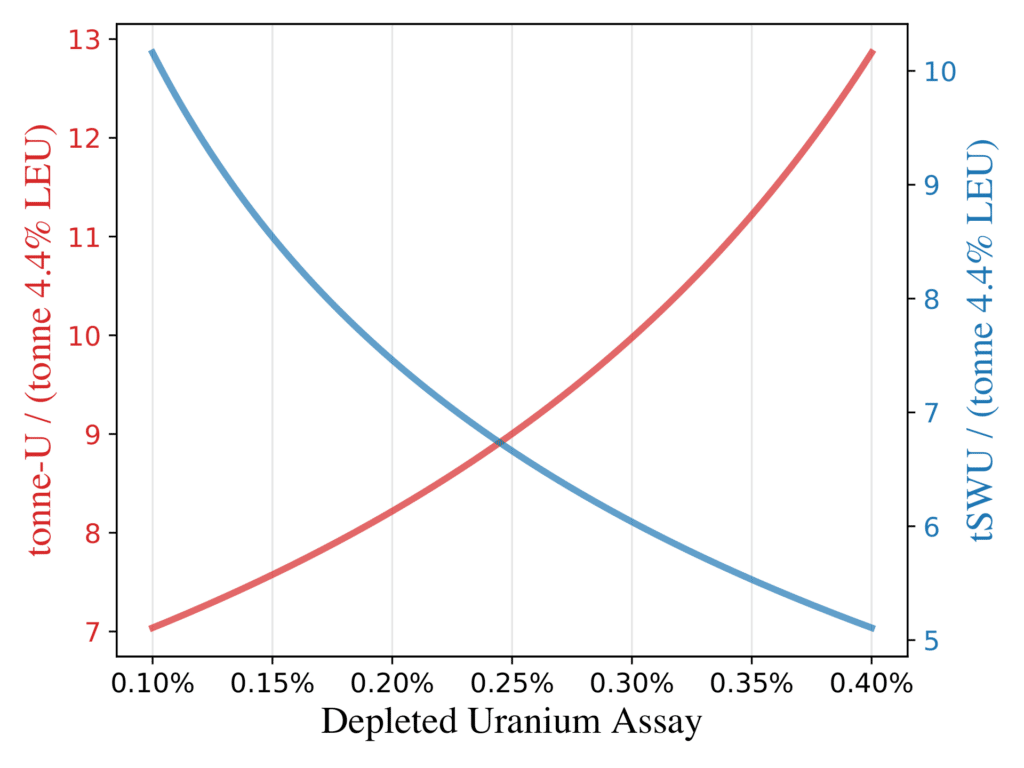US and EU imports of Russian uranium and enrichment services could stop. Here’s how.
By Dory Castillo-Peters, Frank von Hippel | August 5, 2022
 Cigar Lake in Canada is the world's highest-grade uranium mine. (Image courtesy of Cameco)
Cigar Lake in Canada is the world's highest-grade uranium mine. (Image courtesy of Cameco)
Following Russia’s invasion of Ukraine in February, the United States, the European Union, as well as other countries imposed punishing economic sanctions in retaliation for its attack. The United States and the European Union (EU), which combined account for about half the global nuclear power capacity, could go one step further by cutting imports of Russian uranium and uranium enrichment services. This is a shift that has already started spontaneously. Here’s how a complete transition away from Russian nuclear services could happen.
US and EU dependence on Russian nuclear services. In 2021, Russia provided US nuclear utilities with 14 percent of their uranium purchases and 28 percent of their enrichment services. For their part, in 2020, EU utilities imported 20 percent of their natural uranium and 26 percent of their enrichment services from Russia. Combined, annual US and EU imports earn Russia only on the order of $1 billion per year.[1] This is small in comparison to Russia’s earnings of about $200 billion per year from oil and natural gas exports. But ending the US and EU imports of nuclear services from Russia would make them less subject to its blackmail over energy. Also, the loss, along with the cancellation of a new $8 billion reactor order by Finland, would be a setback to Russia’s nuclear conglomerate, Rosatom, which estimated its foreign earnings at about $8 billion in 2021.
Russia has the world’s largest uranium enrichment complex, accounting for almost half the global capacity, but it is a relatively small uranium producer with only six percent of the global supply in 2020. In fact, Russia mines less uranium than it exports to the United States and the EU—for instance, in 2020, it mined 2,800 tonnes while exporting 3,100 and 2,500 tonnes to the United States and the EU, respectively. This is possible because most of the uranium Russia exports is bought from Kazakhstan—a country that is landlocked and ships its uranium to Europe and the United States through Russia. Kazakhstan is the world’s largest uranium producer with 19,500 tonnes in 2020.
North American and European utilities are already actively at work to find alternative sources of supply. In June, the Canadian uranium mining company, Global Atomic, announced a contract with an unnamed major North American utility to develop a mine in Niger that is to produce about 2,000 tonnes of natural uranium annually starting in 2025. To encourage such developments, Democrat Senator Joe Manchin, who is the chairman of the Senate Energy and Natural Resources Committee, and Senator Jim Risch of Idaho, the senior Republican member of the Senate Foreign Relations Committee, introduced, in April, the “International Nuclear Energy Act of 2022.” If passed, the bill would authorize $3.5 billion for a “US nuclear fuels security initiative” aiming to “reduce the reliance on nuclear fuels from Russia and China.”
To make such an initiative work, the overall front end of the nuclear fuel cycle will require adjustments.
Trading uranium for enrichment services. One flexibility in the search for alternative sources of supply is that uranium mining and uranium enrichment activities can be traded off against each other to a considerable extent. Nuclear utilities take advantage of this flexibility to minimize their costs. But to understand how the tradeoff works, one must look at the details.
In natural uranium, only about one atom out of 140 is the chain-reacting isotope uranium 235, whose fission provides most of the heat in the fuel of conventional power plants. Virtually all the remaining 99.3 percent of the uranium is the non-chain-reacting isotope uranium 238. Most of the world’s nuclear power plants are fueled with uranium containing 4 to 5 percent uranium 235. That fuel must therefore be “enriched” in uranium 235 from its level of 0.7 percent in natural uranium before it can be used in a reactor.
Today, uranium enrichment consists of converting natural uranium into gaseous uranium hexafluoride (UF6) and routing the gas through a “cascade” of spinning centrifuges. At each stage, centrifugal force results in gas being pressed against the walls of the spinning cylinders, and, because uranium 238 is heavier than uranium 235, that gas portion contains a slightly higher concentration of uranium 238. This local change in concentration is compensated by a slight depletion in uranium 238 in the gas toward the center of the centrifuges, which becomes slightly enriched in the lighter isotope, uranium 235. This enriched gas portion is skimmed off near the center and sent up the cascade for further enrichment, whereas the gas near the wall is sent down the cascade for extraction of more of the uranium 235 it still contains. Cost minimization results in the amount of uranium 235 that is left in the depleted uranium varying with the ratio of the prices of natural uranium and separative work units. (Separative Work Units are the units in which enrichment companies measure and charge for their services. We use tonne-SWU (tSWU) units here.)
During 2017-2021, US nuclear utilities bought an annual average of 17,500 tonnes of natural uranium and 16,600 tSWUs, including 2,400 tonnes of uranium and 3,300 tSWUs per year from Russia. For their part, during 2016-2020, EU utilities bought an annual average of 13,300 tonnes of natural uranium and 11,300 tSWUs, including 2,800 tonnes of uranium and 3,400 tSWU per year from Russia. Given that the imports from Russia are in the range of 10 to 30 percent, both Russian natural uranium and SWUs could, in principle, be replaced by purchases from other suppliers.
In the short term, however, it may be easier to increase purchases of uranium than to buy more enrichment work from other suppliers. It would, in fact, be possible to produce more low-enriched uranium with the same amount of enrichment work by extracting less uranium 235 per tonne of natural uranium. But maintaining the same level of uranium 235 in the fuel product would increase natural uranium requirements.
For instance, for a typical enrichment level of 4.4 percent (see Figure 1), the ratio of uranium and SWUs bought by US nuclear utilities in 2017-21 corresponds to an average depleted uranium assay of 0.23 percent where 24 percent of the SWUs came from Russia. Reducing US utility SWU purchases by 24 percent would require increasing the assay of the associated depleted uranium to 0.3 percent. In turn, this would result in an increased annual uranium requirement of about 3,000 tonnes of natural uranium per year. Similarly, reducing EU utility purchases of SWUs by the amount bought from Russia could be accomplished by increasing the average depleted uranium assay associated with EU enrichment from 0.216% to 0.285%, which would require EU utilities to buy 1,900 more tonnes of natural uranium annually.
Overall, therefore, ending US and EU utility purchases of Russian uranium and enrichment work could be offset by the purchase of an additional 10,000 tonnes of natural uranium from non-Russian sources.

Reopening uranium mines and increasing enrichment capacity. In recent years, uranium mines with higher extraction costs shut down as the price of uranium declined. In Canada, for example, annual production decreased by about half from 14,000 to 7,000 tonnes between 2016 and 2018 as the uranium spot market price fell from about $90 to $45 per kilogram of uranium. The decline in production came after Cameco, the world’s second-largest uranium supplier based in Canada, suspended operations at two major mines. However, the spot market price of uranium is now back above its 2016 levels. And, even before Russia’s invasion, Cameco announced that starting in 2024 its mines will return to service at two-thirds of their capacity—corresponding to a production of 11,000 tonnes per year. This would already exceed what would be required to replace the imports of uranium and SWUs from Russia by the United States and the EU.
Restarting production at mines takes time. But utilities typically keep buffer stocks covering about three years of uranium requirements to protect themselves from supply interruptions.[2]
SWU prices have been at a historic low in recent years due to an excess in global enrichment capacity. As a result, the European conglomerate Urenco and France’s company Orano allowed their enrichment capacities to slowly decline by not replacing broken centrifuges. But if Russia is now no longer a competitor in the EU and US markets, both Urenco and Orano will likely restart centrifuge production and increase their enrichment capacity. This would result in a mixed strategy of increasing both SWU and natural uranium purchases from non-Russian sources.
In 2020, US and EU purchases of separative work were about 25,000 tSWU, whereas their combined enrichment capacities were approximately 26,000 tSWU. This shows that the United States and the EU could be self-sufficient in enrichment capacity, although they would need to expand somewhat to keep serving their other customers as well.
Uranium conversion and fuel fabrication. In addition to uranium mining and enrichment, the nuclear fuel cycle includes uranium conversion and fuel fabrication (see Figure 2). These steps too are embedded in an international market that will require adjustment as countries seek alternative sources to Russia.

Conversion services—the process of changing uranium from an oxide form into the form of uranium hexafluoride gas for enrichment—are currently being provided by Canada, China, France, and Russia. A large US plant, ConverDyn, in Metropolis, Illinois shut down in 2017—largely because of Russian competition. But it is now scheduled to reopen in 2023. The Metropolis conversion plant had an original design capacity of 15,000 tonnes per year, which was reduced to 7,000 tonnes per year in 2017. According to the operator, the ConverDyn plant could be restored to its design capacity “if supported by demand.” Including the reopened ConverDyn plant, in 2023, Canadian, US, and French conversion capacity will reach 34,500 tonnes per year, which is more than the current requirements of the United States and the EU combined (about 31,000 tonnes per year).
Fuel fabrication, which is typically provided by the manufacturer of a nuclear reactor, begins with the deconversion of enriched gaseous uranium hexafluoride to uranium dioxide powder. Rosatom is the default fuel provider for Soviet- and Russian-design reactors in other countries. Generally, fuel fabrication contracts between the Rosatom and operators of these reactors also include enrichment services. Historic foreign customers for Russia are nuclear utilities in former Soviet Republics and Eastern Europe. In recent years, Russia has also exported reactors to Bangladesh, China, Finland, India, Iran, and Turkey. Soviet- and Russian-designed reactors account for nine percent of global nuclear operating capacity and the capacity of Russian-designed reactors under construction outside Russia will almost double this percentage.
Since 2003, Ukraine’s state-owned utility company Energoatom has worked with US-based Westinghouse to diversify its fuel supply, starting with the supply for the South Ukraine nuclear power plant. In June 2022, Energoatom and Westinghouse signed a contract for the supply of all of Ukraine’s nuclear fuel. If the war ends with Ukraine again controlling its largest, six-unit nuclear power plant outside the city of Zaporizhzhia, this alone would reduce by 40 percent Russia’s current fuel-supply contracts for Soviet and Russian-designed reactors operating abroad.
Other countries importing enriched uranium, however, are in different situations. For instance, although Brazil and Japan have enrichment plants, their capacities are too small to supply enough fuel to support their domestic power plants. Such countries likely will continue to depend on imports of enrichment work and natural uranium, as does South Korea.
The bottom line of this rough analysis is that both the United States and the EU, if they want to, could switch to fueling their reactors with uranium and enrichment work purchased from sources other than Russia. But this would have a relatively small impact on Russia’s trade balance—only about a billion dollars or about half of a percent of Russia’s earnings from the export of oil and natural gas. Indeed, the increase in world prices of oil and natural gas caused by its invasion of Ukraine has already given Russia extra income that dwarfs any losses it would experience from its uranium or enrichment sales.
How much would it cost? Replacing Russian uranium and enrichment services from other sources—if available—could raise concerns about increasing uranium and enrichment costs to US and EU utilities. But these costs are small in comparison to other nuclear costs. The overall cost of nuclear power is mostly driven by the capital investment and salaries for the 500 to 800 people who tend each nuclear power reactor. In 2021, the average costs of uranium and enrichment for US nuclear utilities were $90 per kilogram of natural uranium and $100 per SWU, respectively. For a typical reactor, their combined contributions would be about 4 percent of the average retail price of 10.6 cents for a kilowatt-hour in the United States in 2020.
If the net effect of shifting away from Russian uranium and enrichment were to cause as much as a 50 percent increase in the cost of uranium and SWUs to US utilities, it would increase the retail cost of nuclear power by only 2 percent—much less than June’s year-over-year general inflation rates of about 9 percent in both the United States and the European Union.
The cost of ending dependence on Russia’s nuclear services pales in comparison to the costs Putin’s war has already inflicted on the US and EU economies.
Notes:
[1] For long-term average prices of about $100 per kilogram of natural uranium and $100 per Separative Work Unit.
[2] EIA, Uranium Marketing Annual Report, Table 22, https://www.eia.gov/uranium/marketing/table22.php; ESA, Annual Report, 2020, Figure 8.
Together, we make the world safer.
The Bulletin elevates expert voices above the noise. But as an independent nonprofit organization, our operations depend on the support of readers like you. Help us continue to deliver quality journalism that holds leaders accountable. Your support of our work at any level is important. In return, we promise our coverage will be understandable, influential, vigilant, solution-oriented, and fair-minded. Together we can make a difference.
Keywords: Canada, European Union, Rosatom, Russia-Ukraine, Russian nuclear industry, Ukraine, United States, nuclear exports, uranium enrichment, uranium mining
Topics: Nuclear Energy

















It is sad to realise that even in an age when global-warming is universally viewed as an existential threat, carbon-minimal nuclear-cycle activities are still held hostage by and pegged to carbon-intense fossil fuel price considerations, when it should not have been given any importance whatsoever given the EXISTENTIAL nature of that former threat ! By the way, Figure 2 of this otherwise revealing article is a weenie bit inaccurate : at the ORE stage the material labeled should be U-238 because concentrated and compacted U-235 radioactive isotopes only materialize after further processings.
The UN head calls for ‘no nukes’ at all.
Is this an actual position of the Bulletin?
If the deep state is concerned about carbon emissions why do they shut down nuclear reactors? Why don’t they shut down coal plants? Why do they maintain 10.000 fuel hungry warplanes and and thousands of warships that use more energy than the whole world’s cars?